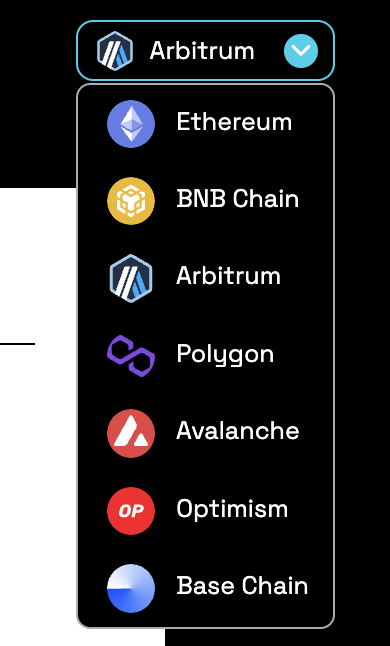
USDC
USD Coin koers
$0,99990
-$0,00010
(-0,01%)
Prijsverandering voor de afgelopen 24 uur

Wat vind je vandaag van USDC?
Deel je mening hier door een duim omhoog te geven als je je bullish voelt over een munt of een duim omlaag als je je bearish voelt.
Stem om resultaten te bekijken
Disclaimer
De sociale inhoud op deze pagina ("Inhoud"), inclusief maar niet beperkt tot tweets en statistieken die door LunarCrush worden verstrekt, is afkomstig van derden en wordt alleen voor informatieve doeleinden geleverd "zoals deze is". OKX geeft geen garantie voor de kwaliteit of nauwkeurigheid van de Inhoud en de Inhoud vertegenwoordigt niet de standpunten van OKX. Het is niet bedoeld om (i) beleggingsadvies of een beleggingsaanbeveling te geven; (ii) een aanbod of verzoek om digitale bezitting te kopen, verkopen of te bezitten; of (iii) financieel, boekhoudkundig, juridisch of fiscaal advies. Digitale bezittingen, waaronder stablecoins en NFT's, brengt een hoog risico met zich mee en kan sterk fluctueren. De prijs en prestaties van de digitale bezittingen zijn niet gegarandeerd en kunnen zonder voorafgaande kennisgeving worden gewijzigd.<br></br>OKX geeft geen beleggings- of vermogensadvies. Je moet zorgvuldig overwegen of het verhandelen of bezitten van digitale bezittingen voor jou geschikt is in het licht van je financiële toestand. Raadpleeg je juridische, fiscale of beleggingsadviseur als je vragen hebt over je specifieke situatie. Raadpleeg voor meer informatie onze <a href="/help/terms-of-service">Gebruiksvoorwaarden</a> en <a href="/help/risk-compliance-disclosure">Risicowaarschuwing</a>. Door gebruik te maken van de website van derden ('TPW'), ga je ermee akkoord dat elk gebruik van de TPW onderworpen is aan en beheerst wordt door de voorwaarden van de TPW. Tenzij uitdrukkelijk schriftelijk vermeld, zijn OKX en haar partners ("OKX") op geen enkele manier verbonden met de eigenaar van de exploitant van de TPW. Je gaat ermee akkoord dat OKX niet verantwoordelijk of aansprakelijk is voor verlies, schade en andere gevolgen die voortvloeien uit jouw gebruik van de TPW. Houd er rekening mee dat het gebruik van een TPW kan leiden tot verlies of vermindering van je bezittingen. Het product is mogelijk niet in alle rechtsgebieden beschikbaar.
USD Coin marktinformatie
Marktkapitalisatie
Marktkapitalisatie wordt berekend door het circulerende aanbod van een munt te vermenigvuldigen met de laatste prijs.
Marktkapitalisatie = Circulerend aanbod × Laatste prijs
Marktkapitalisatie = Circulerend aanbod × Laatste prijs
Circulerend aanbod
Totale bedrag van een munt dat openbaar beschikbaar is op de markt.
Positie marktkapitalisatie
De positie van een munt in termen van marktkapitalisatie.
Historisch hoogtepunt
Hoogste prijs die een munt heeft bereikt in zijn handelsgeschiedenis.
Historisch dieptepunt
Laagste prijs die een munt heeft bereikt in zijn handelsgeschiedenis.
Marktkapitalisatie
$60,67B
Circulerend aanbod
60.670.324.313 USDC
99,99% van
60.670.731.875 USDC
Positie marktkapitalisatie
--
Audits

Laatste audit: 1 jun 2020
24u hoog
$1,0001
24u laag
$0,99980
Historisch hoogtepunt
$1,0400
-3,86% (-$0,04010)
Laatste update: 19 mei 2021
Historisch dieptepunt
$0,87450
+14,33% (+$0,12540)
Laatste update: 11 mrt 2023
USD Coin Feed
De volgende inhoud is afkomstig van .

ChainCatcher 链捕手
Auteurs: Scof, ChainCatcher
Redactie: TB, ChainCatcher
Er was geen warming-up, geen grote positieve punten, maar het crypto-conceptaandeel Bakkt steeg van de ene op de andere dag met meer dan 50%.
Nog niet zo lang geleden werd Bakkt door de markt gemarginaliseerd door het verlies van klanten en dalende inkomsten, maar nu is het plotseling overgestapt op de hete zoektocht en is het de helderste aanwezigheid in crypto-aandelen geworden. Welk ritme is er achter de schijnbaar toevallige golf getrapt? Is het een speculatief spel op korte termijn, of is het een signaal dat de trend in de branche stilletjes aan het keren is?
Bakkt schiet omhoog, is het een kans of een emotie?
Op 13 mei steeg de aandelenkoers van Bakkt in korte tijd met meer dan 50%. Het bedrijf, ooit gezien als een "brug tussen traditionele financiën en de cryptowereld", is de afgelopen jaren verwikkeld geraakt in klantverloop en krimpende inkomsten, en deze plotselinge ommekeer heeft de aandacht van de markt getrokken. De schijnbare reden was dat het in het eerste kwartaal een nettowinst van $ 7,7 miljoen behaalde, de eerste winst in de afgelopen jaren. Bij nadere beschouwing van het winstrapport blijkt echter dat dit vooral te wijten is aan kostenbesparingen en eenmalige aanpassingen, en dat de kernactiviteiten niet significant zijn verbeterd.
Wat de stemming echt aanwakkerde, was de nieuwe strategie die door het bedrijf werd uitgebracht. Bakkt kondigde een samenwerking aan met DTR, opgericht door voormalige SoftBank-managers, om AI-plug-ins en stablecoin-betalingsdiensten te lanceren, waarmee het populaire "PayFi"-spoor wordt doorbroken, een wereldwijde betalingsinfrastructuur die AI-agenten en on-chain afwikkeling combineert. Dit "nieuwe verhaal" van het over elkaar heen leggen van AI en encryptie leidde al snel tot marktspeculatie.
Daarnaast is het "M&A-concept" van Bakkt gereactiveerd. Hoewel de vorige overnameonderhandelingen met Trump's TMTG mislukten, heeft ICE nog steeds meer dan de helft van zijn aandelen in handen en gaat het gerucht dat Apex Fintech het zou kunnen overnemen. Gedreven door een zeer kleine oplage en een hoog aandeel shortposities tot 23%, werd de shortmarkt snel geënsceneerd en werd de aandelenkoers snel verhoogd.
Vanuit fundamenteel oogpunt staat het platform nog steeds onder enorme druk. Aan de ene kant zal Webull, een aan de NASDAQ genoteerde beursvennootschap voor de belangrijkste klant van Bakkt, in juni de samenwerking met het bedrijf beëindigen. Bakkt leverde vroeger cryptocurrency-handel en bewaringsdiensten aan Webull, die vroeger goed was voor meer dan 70% van de totale inkomsten van Bakkt. Aan de andere kant zal Bank of America ook haar samenwerking met Bakgt beëindigen, wat gevolgen zal hebben voor het segment loyaliteitsdiensten van Bakkt, dat zich richt op het inwisselen van punten, digitale beloningen en andere oplossingen voor zakelijke klanten.
Met het verlies van twee grote klanten is de inkomstenstructuur van Bakkt kwetsbaarder geworden. Deze ronde van stijging lijkt meer op een geconcentreerde publicatie van het marktsentiment op korte termijn dan op een substantieel keerpunt in de fundamentals.
Crypto-aandelen zijn collectief onrustig, waar gokt de markt op?
De anomalie van Bakkt is geen geïsoleerd fenomeen. In dezelfde periode werd de crypto-conceptaandelensector over het algemeen sterker en stegen veel individuele aandelen aanzienlijk. Coinbase steeg met 23,97%, TeraWulf voegde 10,06% toe, Amber Group en DMG Blockchain stegen bijna 10% en MicroStrategy herstelde ook meer dan 4%. Over het algemeen steeg de crypto-aandelensector deze week met bijna 10%, wat de intensieve lay-out van fondsen in dit spoor aantoont.
Belangrijker is echter dat de markt de waarde van de crypto-"infrastructuur" opnieuw begint te onderzoeken. In de afgelopen paar cycli van de cryptomarkt ging het grootste deel van het geld naar beurzen, platformmunten of mijnbouwbedrijven, maar nu richten beleggers geleidelijk hun aandacht op die "pijplijn"-bedrijven - bedrijven die bewaring, afwikkeling, clearing, compliance, risicobeheer en andere diensten aanbieden. Ze lijken meer op de waterkracht en steenkool van dit ecosysteem, met een stabiel inkomensmodel, en het is gemakkelijker om zich aan te passen aan het waarderingssysteem van traditionele financiën. De stijging van Bakkt raakt deze structurele voorkeur, en het is niet de enige.
Traditionele financiën zijn in volle gang
Het echte keerpunt van de crypto-industrie is niet de kortstondige stijging van de aandelenkoers van een bepaald platform, maar het feit dat steeds meer traditionele financiële instellingen ervoor kiezen om mee te doen.
Online makelaars in Hong Kong hebben het voortouw genomen. Futu Securities lanceerde een cryptocurrency-handelsservice, waarmee gebruikers rechtstreeks reguliere valuta's zoals Bitcoin, Ethereum en USDT kunnen storten en verhandelen via hun aandelenrekeningen in Hong Kong en de VS. Tiger Brokers heeft de stortings-, handels- en opnamefuncties van crypto-activa gelanceerd en deze verbonden met traditionele aandelenhandel. Victory Securities heeft ook een licentie om crypto-activa-gerelateerde bedrijven te ondersteunen en de markt te leiden. De dochteronderneming van Standard Chartered in Hong Kong heeft aangekondigd dat het samen met haar partners zal deelnemen aan de stablecoin-sandbox van de Hong Kong Monetary Authority, in een poging om on-chain betalingsoplossingen te verkennen in het kader van het nalevingskader.
Tegelijkertijd bewegen de wereldwijde betalingsreuzen zich agressiever. Stripe lanceert stablecoin-accounts en programmeerbare stablecoin USDB in 101 landen; Visa en Mastercard hebben hun integratie met partners zoals Circle uitgebreid, door stablecoins zoals USDC te verbinden met hun betalingsnetwerken, waardoor gebruikers on-chain activa kunnen uitgeven via traditionele kaarten. PayPal gebruikt een rendement van 3,7% om gebruikers aan te trekken om PYUSD aan te houden, in een poging een gesloten afwikkelingslus op te bouwen op basis van stablecoins. Zelfs gevestigde grensoverschrijdende overmakingsbedrijven zoals MoneyGram verbinden traditionele contanten en on-chain activa via de stablecoin "Ramps", die meer dan 170 landen bestrijkt.
Het gemeenschappelijke punt van deze trends is dat de traditionele financiële wereld crypto niet langer als een overstromingsbeest beschouwt, maar zichzelf actief is gaan "on-chainen". Dit is zowel een antwoord op veranderingen in de behoeften van gebruikers als een streven naar kostenefficiëntie. Stablecoins en blockchain-technologie bieden een snellere, goedkopere en transparantere infrastructuur dan traditionele netwerken met hoge kosten en trage afwikkelingen. En wie in dit nieuwe systeem de eerste plaats kan innemen, heeft meer kans om mee te zeggen over de toekomstige financiële kaart.
De nieuwe strategie van Bakkt is het resultaat van deze trend. Hoewel het qua volume en technologie niet zo groot is als Stripe en Visa, kan het als instelling met een nationale licentie en bewarings- en clearingcapaciteiten toch een doelwit worden voor fusies en overnames of een toegang tot samenwerking. Dat is precies waarom de markt het herwaardeert - niet door hoeveel geld het vandaag verdient, maar door of het het potentieel heeft om het volgende ticket te zijn.
epiloog
De Bakkt-golf is een microkosmos van deze golf, maar het is niet het hele verhaal. Naarmate de kapitaalmarkt de waarde van crypto-infrastructuur opnieuw begint te onderzoeken, steeds meer traditionele financiële instellingen cryptotechnologie niet langer uit de weg gaan en "on-chain finance" een uitvoerbare strategie wordt in plaats van een verre fantasie, zijn we getuige van het begin van een ommekeer.
In deze ronde is het niet door slogans te schreeuwen om geld te verdienen, maar door degenen die echt bruggen bouwen, wegen plaveien en verbinding maken met reguliere systemen om waarde achter te laten.
Origineel weergeven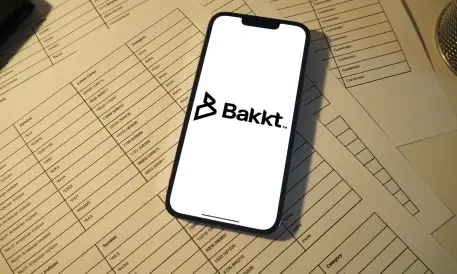
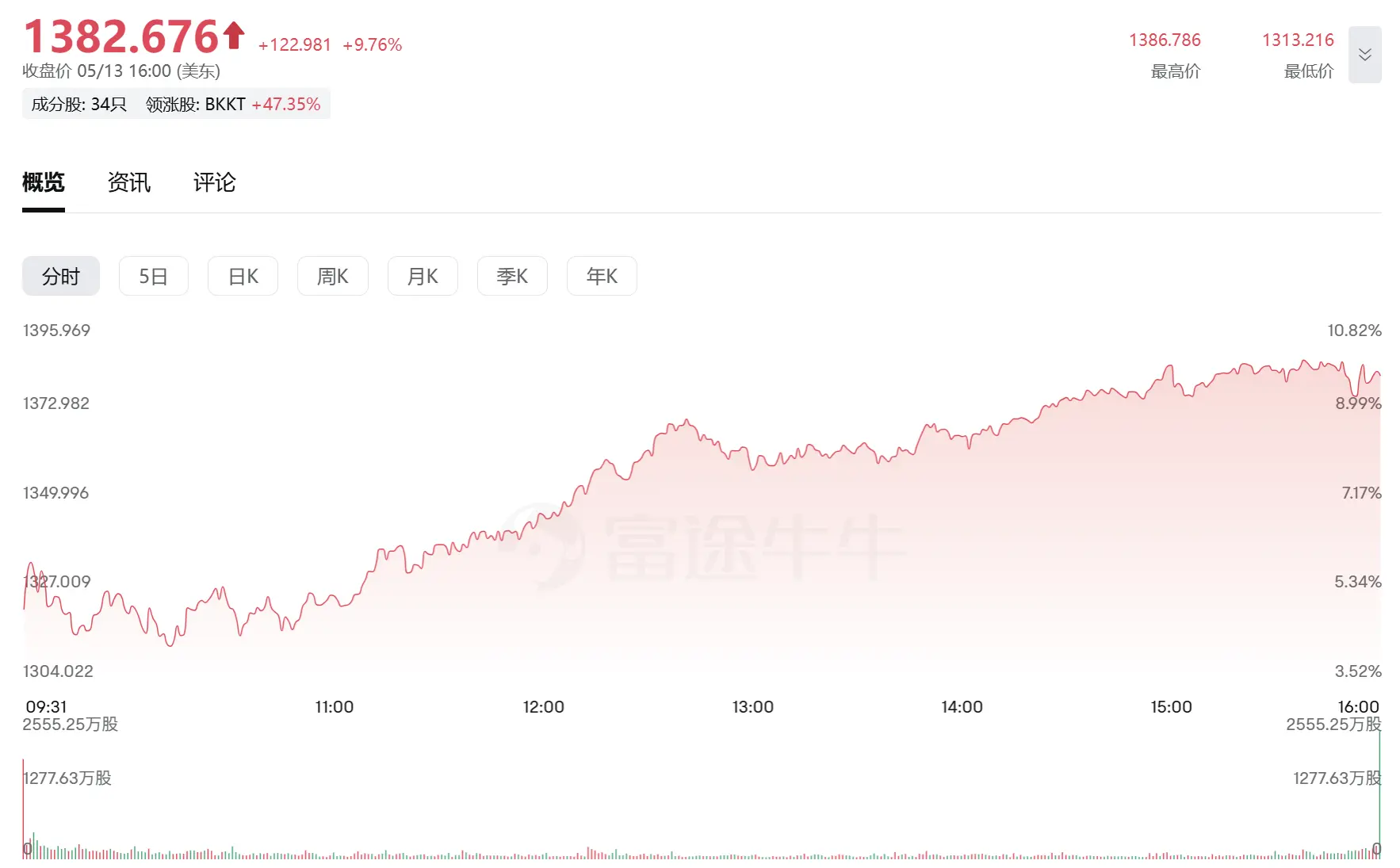
6,35K
0

David_Crypto
Yayoi Kusama-collectie komt naar DuckChain

DuckChain
🎨 Gefractioneerde beeldende kunst "Pumpkin (2)" van Yayoi Kusama is zojuist geland op DuckChain!
Mint nu om een stuk van dit RWA-meesterwerk te bezitten van een van de meest iconische en waardevolle levende kunstenaars
- bekend om haar samenwerkingen met Louis Vuitton, Apple en voor het leiden van grote kunstcross-overs op Base, Linea, Polygon en Ethereum.
👉
Munt op #DuckChain voor 21 mei om belangrijke beloningen te ontgrendelen:
• 400 gelukkige deelnemers ontvangen een deel van de USDC-prijs van $ 2.000
• Krijg een boost van 25% $ART op elke munt
• Verdien 1 gratis breuk als je 5+ breuken verzamelt
• Scoor een exclusieve DuckChain Dotchi-avatar
Topminters ontvangen ook royale beloningen in $ART en $DUCK.
Pak je $DUCK en munt nu je stuk!
📖 Volledige gids voor munt:
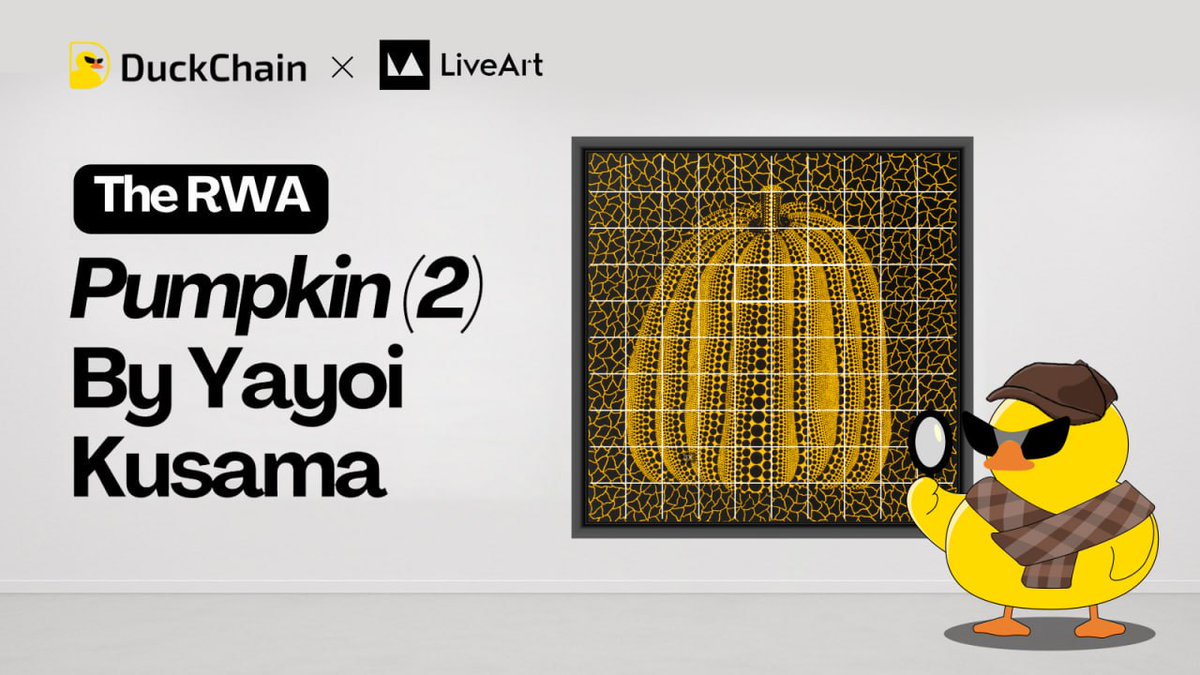
2,25K
1

Martin Ho
Gefeliciteerd! @0xSoulProtocol project wijst 1,5% van de tokens toe aan Yappers.

Kaito AI 🌊
Het volgende Pre-TGE Yapper Leaderboard is live met @0xSoulProtocol!
Met grote beloningen opzij, nu op ons Rewards Station:
Soul wijst 1,5% van hun aankomende tokenvoorraad toe aan Yappers en het bredere Kaito-ecosysteem.
- 0,5% tot de beste Soul yappers
- 0,5% voor alle yappers, op basis van de hoeveelheid zaden (hun productpuntensysteem)
- 0,5% voor de Kaito eco op basis van het totale aantal zaden mijlpalen
Om deel te nemen, moet je de code KAITO op hun website invoeren.
Bovenop dit alles geven ze ook onze $5k USDC aan wekelijkse beloningen aan de top 25 yappers op hun leaderboard!
Meer details 👇

2,35K
7

CrunchDAO 🧠
Een nieuwe samenwerking tussen Crunch en ADIA Lab begint vandaag!
In samenwerking met @lopezdeprado, Alex Lipton en Horst pakt de Crunch-community een ander fundamenteel gebied in datawetenschap aan: Time Series Structural Breaks!
Vorig jaar concurreerde de Crunch-gemeenschap en bouwde het beste algoritme voor causale ontdekking tot nu toe. Voor de komende 6 maanden is het ons doel om de state-of-the-art op het gebied van structurele breukdetectie naar een geheel nieuw niveau te tillen!
$100.000 USDC bounty beloning voor de beste modelbouwers!
Tot ziens op Crunch. De inschrijving is nu geopend!
🧵
Origineel weergeven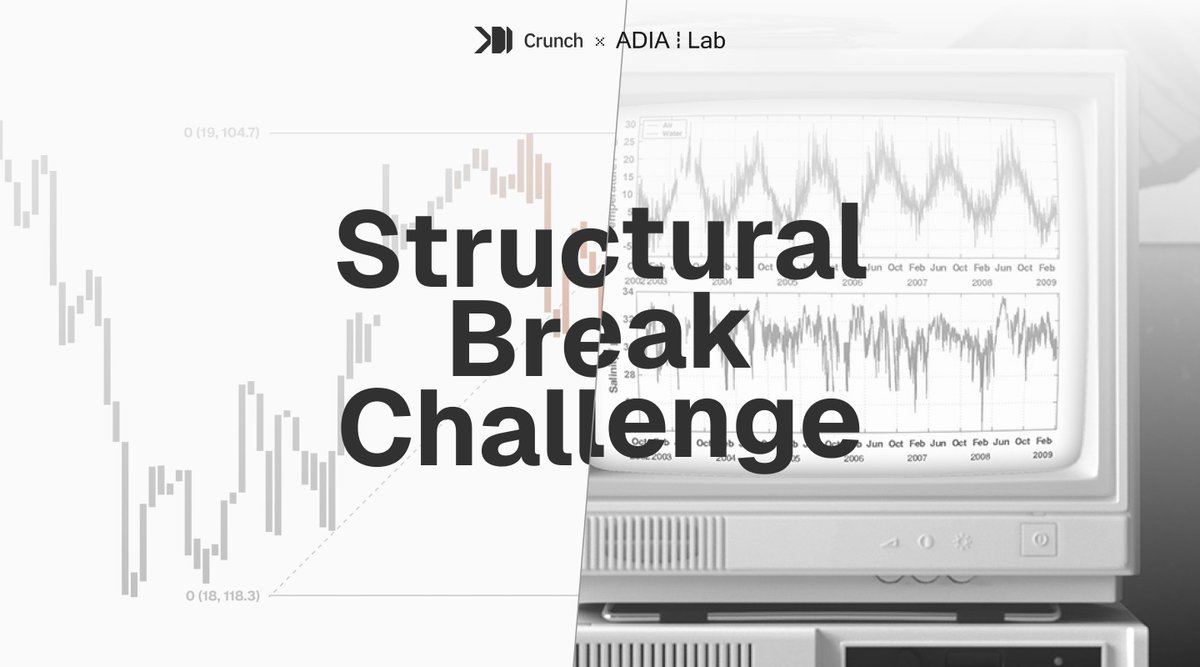
3,36K
13
USDC-calculator


USD Coin prijsprestatie in USD
De huidige koers van USD Coin is $0,99990. Gedurende de afgelopen 24 uur, USD Coin is met afgenomen tegen -0,01%. Het heeft momenteel een circulerend aanbod van 60.670.324.313 USDC en een maximaal aanbod van 60.670.731.875 USDC, waardoor het een volledig verwaterde marktkapitalisatie van $60,67B heeft. Op dit moment bezit de USD Coin-munt, de 0 positie in de marktkapitalisatie positie. De USD Coin/USD-prijs wordt in real time geüpdatet.
Vandaag
-$0,00010
-0,01%
7 dagen
-$0,00010
-0,01%
30 dagen
-$0,00030
-0,03%
3 maanden
-$0,00020
-0,02%
Populaire USD Coin-conversies
Laatste update: 14-05-2025, 22:10
| 1 USDC tot USD | $ 1,0000 |
| 1 USDC tot EUR | € 0,89150 |
| 1 USDC tot PHP | ₱ 55,8670 |
| 1 USDC tot IDR | Rp 16.550,81 |
| 1 USDC tot GBP | £ 0,75098 |
| 1 USDC tot CAD | $ 1,3958 |
| 1 USDC tot AED | AED 3,6731 |
| 1 USDC tot VND | ₫ 25.940,34 |
Over USD Coin (USDC)
De beoordeling is een algehele waardering die OKX verzamelt vanaf verschillende bronnen en is alleen bestemd voor intern gebruik. OKX geeft geen garantie wat betreft de kwaliteit of de nauwkeurigheid van een beoordeling. Deze is niet bedoeld als (i) beleggingsadvies of -aanbeveling, (ii) een aanbod voor of verzoek om digitale activa te kopen, te verkopen of aan te houden, of (iii) advies op het gebied van financiën, boekhouding of belastingen. Digitale activa, waaronder stablecoins en NFT's, brengen aanzienlijke risico’s met zich mee. Ze kunnen sterk fluctueren in waarde of zelfs waardeloos worden. De prijzen en bewegingen van digitale activa zijn onvoorspelbaar en kunnen zomaar veranderen. Je digitale activa zijn niet verzekerd tegen mogelijke verliezen. In het verleden behaalde resultaten bieden geen garantie voor de toekomst. OKX garandeert geen terugbetaling van de hoofdsom of rente. OKX geeft geen aanbevelingen voor investeringen of activa. Voordat je besluit om digitale activa te verhandelen of aan te houden, moet je zorgvuldig analyseren of jouw financiële situatie dit toelaat. Raadpleeg bij vragen hierover altijd een juridisch, fiscaal of beleggingsadviseur.
Verder lezen
- Officiële website
- Whitepaper
- Github
- Blokverkenner
Informatie over websites van derden
Informatie over websites van derden
Door de website van derden ('TPW') te gebruiken, aanvaard je dat elk gebruik van de TPW onderworpen is aan en geregeld wordt door de voorwaarden van de TPW. Tenzij uitdrukkelijk schriftelijk vermeld, zijn OKX en haar partners ('OKX') op geen enkele wijze verbonden met de eigenaar of exploitant van de TPW. Je stemt ermee in dat OKX niet verantwoordelijk of aansprakelijk is voor verlies, schade en andere gevolgen die voortvloeien uit je gebruik van de TPW. Houd er rekening mee dat het gebruik van een TPW kan leiden tot verlies of waardevermindering van je bezittingen.
USD Coin Veelgestelde vragen
Hoe veel is één USD Coin vandaag waard?
Momenteel is één USD Coin de waarde van $0,99990. Voor antwoorden en inzicht in de prijsactie van USD Coin ben je op de juiste plek. Ontdek de nieuwste USD Coin grafieken en handel verantwoord met OKX.
Wat is cryptocurrency?
Cryptocurrency's, zoals USD Coin, zijn digitale bezittingen die op een openbaar grootboek genaamd blockchains werken. Voor meer informatie over munten en tokens die op OKX worden aangeboden en hun verschillende kenmerken, inclusief live-prijzen en grafieken in real time.
Wanneer zijn cryptocurrency's uitgevonden?
Dankzij de financiële crisis van 2008 nam de belangstelling voor gedecentraliseerde financiën toe. Bitcoin bood een nieuwe oplossing door een veilige digitale bezitting te zijn op een gedecentraliseerd netwerk. Sindsdien zijn er ook veel andere tokens zoals USD Coin aangemaakt.
Zal de prijs van USD Coin vandaag stijgen?
Bekijk onze USD Coin Prijsvoorspellingspagina om toekomstige prijzen te voorspellen en je prijsdoelen te bepalen.
ESG-vermelding
ESG-regelgeving (Environmental, Social, and Governance) voor crypto-bezit is gericht op het aanpakken van hun milieu-impact (bijv. energie-intensieve mining), het bevorderen van transparantie en het waarborgen van ethische bestuurspraktijken om de crypto-industrie op één lijn te brengen met bredere duurzaamheids- en maatschappelijke doelen. Deze regels stimuleren de naleving van normen die risico's beperken en het vertrouwen in digitale bezitting bevorderen.
Details bezittingen
Naam
OKcoin Europe LTD
Identificatiecode relevante juridische entiteit
54930069NLWEIGLHXU42
Naam van het crypto-bezit
USD Coin
Consensusmechanisme
USD Coin is present on the following networks: algorand, avalanche, ethereum, flow, hedera_hbar, solana, stellar, tron.
The Algorand blockchain utilizes a consensus mechanism termed Pure Proof-of-Stake (PPoS). Consensus, in this context, describes the method by which blocks are selected and appended to the blockchain. Algorand employs a verifiable random function (VRF) to select leaders who propose blocks for each round. Upon block proposal, a pseudorandomly selected committee of voters is chosen to evaluate the proposal. If a supermajority of these votes are from honest participants, the block is certified. What makes this algorithm a Pure Proof of Stake is that users are chosen for committees based on the number of algos in their accounts. This system leverages random committee selection to maintain high performance and inclusivity within the network. The consensus process involves three stages: 1. Propose: A leader proposes a new block. 2. Soft Vote: A committee of voters assesses the proposed block. 3. Certify Vote: Another committee certifies the block if it meets the required honesty threshold.
The Avalanche blockchain network employs a unique Proof-of-Stake consensus mechanism called Avalanche Consensus, which involves three interconnected protocols: Snowball, Snowflake, and Avalanche. Avalanche Consensus Process 1. Snowball Protocol: o Random Sampling: Each validator randomly samples a small, constant-sized subset of other validators. Repeated Polling: Validators repeatedly poll the sampled validators to determine the preferred transaction. Confidence Counters: Validators maintain confidence counters for each transaction, incrementing them each time a sampled validator supports their preferred transaction. Decision Threshold: Once the confidence counter exceeds a pre-defined threshold, the transaction is considered accepted. 2. Snowflake Protocol: Binary Decision: Enhances the Snowball protocol by incorporating a binary decision process. Validators decide between two conflicting transactions. Binary Confidence: Confidence counters are used to track the preferred binary decision. Finality: When a binary decision reaches a certain confidence level, it becomes final. 3. Avalanche Protocol: DAG Structure: Uses a Directed Acyclic Graph (DAG) structure to organize transactions, allowing for parallel processing and higher throughput. Transaction Ordering: Transactions are added to the DAG based on their dependencies, ensuring a consistent order. Consensus on DAG: While most Proof-of-Stake Protocols use a Byzantine Fault Tolerant (BFT) consensus, Avalanche uses the Avalanche Consensus, Validators reach consensus on the structure and contents of the DAG through repeated Snowball and Snowflake.
The Ethereum network uses a Proof-of-Stake Consensus Mechanism to validate new transactions on the blockchain. Core Components 1. Validators: Validators are responsible for proposing and validating new blocks. To become a validator, a user must deposit (stake) 32 ETH into a smart contract. This stake acts as collateral and can be slashed if the validator behaves dishonestly. 2. Beacon Chain: The Beacon Chain is the backbone of Ethereum 2.0. It coordinates the network of validators and manages the consensus protocol. It is responsible for creating new blocks, organizing validators into committees, and implementing the finality of blocks. Consensus Process 1. Block Proposal: Validators are chosen randomly to propose new blocks. This selection is based on a weighted random function (WRF), where the weight is determined by the amount of ETH staked. 2. Attestation: Validators not proposing a block participate in attestation. They attest to the validity of the proposed block by voting for it. Attestations are then aggregated to form a single proof of the block’s validity. 3. Committees: Validators are organized into committees to streamline the validation process. Each committee is responsible for validating blocks within a specific shard or the Beacon Chain itself. This ensures decentralization and security, as a smaller group of validators can quickly reach consensus. 4. Finality: Ethereum 2.0 uses a mechanism called Casper FFG (Friendly Finality Gadget) to achieve finality. Finality means that a block and its transactions are considered irreversible and confirmed. Validators vote on the finality of blocks, and once a supermajority is reached, the block is finalized. 5. Incentives and Penalties: Validators earn rewards for participating in the network, including proposing blocks and attesting to their validity. Conversely, validators can be penalized (slashed) for malicious behavior, such as double-signing or being offline for extended periods. This ensures honest participation and network security.
Flow employs a Proof of Stake (PoS) model with a multi-role node architecture and the HotStuff Byzantine Fault Tolerant (BFT) protocol to achieve high throughput, scalability, and fast finality. Core Components of Flow’s Consensus: 1. Proof of Stake with Multi-Role Architecture: Specialized Node Roles: Flow’s PoS model features a multi-node architecture where node roles are divided among different types of specialized nodes, each responsible for specific tasks. This separation enhances scalability by allowing nodes to focus on particular operations, leading to efficient transaction processing and high throughput. 2. HotStuff Consensus Algorithm: Optimized for High Throughput and Fast Finality: Flow utilizes an optimized version of the HotStuff consensus protocol, which is designed to support high-speed, low-latency transactions essential for Flow’s performance-oriented blockchain. BFT Compliance: HotStuff is a BFT protocol, allowing it to tolerate up to one-third of nodes acting maliciously without compromising the network’s security. This resilience ensures the network remains secure and functional, even with potential faults or dishonest nodes. 3. Leader-Based Block Proposal: Leader and Replica Nodes: HotStuff operates with a leader-based approach where a designated leader node proposes new blocks, and other nodes (replicas) validate these blocks. This method simplifies the consensus process, reducing complexity and improving efficiency. Leader Rotation Mechanism: To prevent centralization and enhance fault tolerance, HotStuff incorporates a leader rotation system, replacing the leader if it becomes unresponsive or acts maliciously. This rotation ensures continuous network reliability and minimizes downtime.
Hedera Hashgraph operates on a unique Hashgraph consensus algorithm, a directed acyclic graph (DAG) system that diverges from traditional blockchain technology. It uses Asynchronous Byzantine Fault Tolerance (aBFT) to secure the network. Core Components: 1. Hashgraph Consensus and aBFT: Hedera Hashgraph’s consensus mechanism achieves aBFT, which allows the network to tolerate malicious nodes without compromising security, ensuring high levels of fault tolerance and stability. 2. Gossip about Gossip Protocol: The network employs a "Gossip about Gossip" protocol, where nodes share transaction information along with details of previous gossip events. This process allows each node to rapidly learn the entire network state, enhancing communication efficiency and minimizing latency. 3. Virtual Voting: Hedera does not rely on traditional miners or stakers. Instead, it uses virtual voting, where nodes reach consensus by analyzing the gossip history and simulating votes based on the order and frequency of transactions received. Virtual voting eliminates the need for actual voting messages, reducing network congestion and speeding up consensus. 4. Deterministic Finality: Once consensus is reached, transactions achieve deterministic finality instantly, making them irreversible and confirmed within seconds. This attribute is ideal for applications needing quick and irreversible transaction confirmations. 5. Staking for Network Security: Hedera incorporates staking to bolster network security. HBAR holders can stake their tokens to support validator nodes, contributing to the network’s resilience and encouraging long-term engagement in consensus operations.
Solana uses a unique combination of Proof of History (PoH) and Proof of Stake (PoS) to achieve high throughput, low latency, and robust security. Here’s a detailed explanation of how these mechanisms work: Core Concepts 1. Proof of History (PoH): Time-Stamped Transactions: PoH is a cryptographic technique that timestamps transactions, creating a historical record that proves that an event has occurred at a specific moment in time. Verifiable Delay Function: PoH uses a Verifiable Delay Function (VDF) to generate a unique hash that includes the transaction and the time it was processed. This sequence of hashes provides a verifiable order of events, enabling the network to efficiently agree on the sequence of transactions. 2. Proof of Stake (PoS): Validator Selection: Validators are chosen to produce new blocks based on the number of SOL tokens they have staked. The more tokens staked, the higher the chance of being selected to validate transactions and produce new blocks. Delegation: Token holders can delegate their SOL tokens to validators, earning rewards proportional to their stake while enhancing the network's security. Consensus Process 1. Transaction Validation: Transactions are broadcast to the network and collected by validators. Each transaction is validated to ensure it meets the network’s criteria, such as having correct signatures and sufficient funds. 2. PoH Sequence Generation: A validator generates a sequence of hashes using PoH, each containing a timestamp and the previous hash. This process creates a historical record of transactions, establishing a cryptographic clock for the network. 3. Block Production: The network uses PoS to select a leader validator based on their stake. The leader is responsible for bundling the validated transactions into a block. The leader validator uses the PoH sequence to order transactions within the block, ensuring that all transactions are processed in the correct order. 4. Consensus and Finalization: Other validators verify the block produced by the leader validator. They check the correctness of the PoH sequence and validate the transactions within the block. Once the block is verified, it is added to the blockchain. Validators sign off on the block, and it is considered finalized. Security and Economic Incentives 1. Incentives for Validators: Block Rewards: Validators earn rewards for producing and validating blocks. These rewards are distributed in SOL tokens and are proportional to the validator’s stake and performance. Transaction Fees: Validators also earn transaction fees from the transactions included in the blocks they produce. These fees provide an additional incentive for validators to process transactions efficiently. 2. Security: Staking: Validators must stake SOL tokens to participate in the consensus process. This staking acts as collateral, incentivizing validators to act honestly. If a validator behaves maliciously or fails to perform, they risk losing their staked tokens. Delegated Staking: Token holders can delegate their SOL tokens to validators, enhancing network security and decentralization. Delegators share in the rewards and are incentivized to choose reliable validators. 3. Economic Penalties: Slashing: Validators can be penalized for malicious behavior, such as double-signing or producing invalid blocks. This penalty, known as slashing, results in the loss of a portion of the staked tokens, discouraging dishonest actions.
Stellar uses a unique consensus mechanism known as the Stellar Consensus Protocol (SCP): Core Concepts 1. Federated Byzantine Agreement (FBA): SCP is built on the principles of Federated Byzantine Agreement (FBA), which allows decentralized, leaderless consensus without the need for a closed system of trusted participants. Quorum Slices: Each node in the network selects a set of other nodes (quorum slice) that it trusts. Consensus is achieved when these slices overlap and collectively agree on the transaction state. 2. Nodes and Validators: Nodes: Nodes running the Stellar software participate in the network by validating transactions and maintaining the ledger. Validators: Nodes that are responsible for validating transactions and reaching consensus on the state of the ledger. Consensus Process 3. Transaction Validation: Transactions are submitted to the network and nodes validate them based on predetermined rules, such as sufficient balances and valid signatures. 4. Nomination Phase: Nomination: Nodes nominate values (proposed transactions) that they believe should be included in the next ledger. Nodes communicate their nominations to their quorum slices. Agreement on Nominations: Nodes vote on the nominated values, and through a process of voting and federated agreement, a set of candidate values emerges. This phase continues until nodes agree on a single value or a set of values. 5. Ballot Protocol (Voting and Acceptance): Balloting: The agreed-upon values from the nomination phase are then put into ballots. Each ballot goes through multiple rounds of voting, where nodes vote to either accept or reject the proposed values. Federated Voting: Nodes exchange votes within their quorum slices, and if a value receives sufficient votes across overlapping slices, it moves to the next stage. Acceptance and Confirmation: If a value gathers enough votes through multiple stages (prepare, confirm, externalize), it is accepted and externalized as the next state of the ledger. 6. Ledger Update: Once consensus is reached, the new transactions are recorded in the ledger. Nodes update their copies of the ledger to reflect the new state. Security and Economic Incentives 7. Trust and Quorum Slices: Nodes are free to choose their own quorum slices, which provides flexibility and decentralization. The overlapping nature of quorum slices ensures that the network can reach consensus even if some nodes are faulty or malicious. 8. Stability and Security: SCP ensures that the network can achieve consensus efficiently without relying on energy-intensive mining processes. This makes it environmentally friendly and suitable for high-throughput applications. 9. Incentive Mechanisms: Unlike Proof of Work (PoW) or Proof of Stake (PoS) systems, Stellar does not rely on direct economic incentives like mining rewards. Instead, the network incentivizes participation through the intrinsic value of maintaining a secure, efficient, and reliable payment network.
The Tron blockchain operates on a Delegated Proof of Stake (DPoS) consensus mechanism, designed to improve scalability, transaction speed, and energy efficiency. Here's a breakdown of how it works: 1. Delegated Proof of Stake (DPoS): Tron uses DPoS, where token holders vote for a group of delegates known as Super Representatives (SRs)who are responsible for validating transactions and producing new blocks on the network. Token holders can vote for SRs based on their stake in the Tron network, and the top 27 SRs (or more, depending on the protocol version) are selected to participate in the block production process. SRs take turns producing blocks, which are added to the blockchain. This is done on a rotational basis to ensure decentralization and prevent control by a small group of validators. 2. Block Production: The Super Representatives generate new blocks and confirm transactions. The Tron blockchain achieves block finality quickly, with block production occurring every 3 seconds, making it highly efficient and capable of processing thousands of transactions per second. 3. Voting and Governance: Tron’s DPoS system also allows token holders to vote on important network decisions, such as protocol upgrades and changes to the system’s parameters. Voting power is proportional to the amount of TRX (Tron’s native token) that a user holds and chooses to stake. This provides a governance system where the community can actively participate in decision-making. 4. Super Representatives: The Super Representatives play a crucial role in maintaining the security and stability of the Tron blockchain. They are responsible for validating transactions, proposing new blocks, and ensuring the overall functionality of the network. Super Representatives are incentivized with block rewards (newly minted TRX tokens) and transaction feesfor their work.
Stimuleringsmechanismen en toepasselijke vergoedingen
USD Coin is present on the following networks: algorand, avalanche, ethereum, flow, hedera_hbar, solana, stellar, tron.
Algorand's consensus mechanism, Pure Proof-of-Stake (PPoS), relies on the participation of token holders (stakers) to ensure the network's security and integrity: 1. Participation Rewards: o Staking Rewards: Users who participate in the consensus protocol by staking their ALGO tokens earn rewards. These rewards are distributed periodically and are proportional to the amount of ALGO staked. This incentivizes users to hold and stake their tokens, contributing to network security and stability. o Node Participation Rewards: Validators, also known as participation nodes, are responsible for proposing and voting on blocks. These nodes receive additional rewards for their active role in maintaining the network. 2. Transaction Fees: o Flat Fee Model: Algorand employs a flat fee model for transactions, which ensures predictability and simplicity. The standard transaction fee on Algorand is very low (around 0.001 ALGO per transaction). These fees are paid by users to have their transactions processed and included in a block. o Fee Redistribution: Collected transaction fees are redistributed to participants in the network. This includes stakers and validators, further incentivizing their participation and ensuring continuous network operation. 3. Economic Security: o Token Locking: To participate in the consensus mechanism, users must lock up their ALGO tokens. This economic stake acts as a security deposit that can be slashed (forfeited) if the participant acts maliciously. The potential loss of staked tokens discourages dishonest behavior and helps maintain network integrity. Fees on the Algorand Blockchain 1. Transaction Fees: o Algorand uses a flat transaction fee model. The current standard fee is 0.001 ALGO per transaction. This fee is minimal compared to other blockchain networks, ensuring affordability and accessibility. 2. Smart Contract Execution Fees: o Fees for executing smart contracts on Algorand are also designed to be low. These fees are based on the computational resources required to execute the contract, ensuring that users are only charged for the actual resources they consume. 3. Asset Creation Fees: o Creating new assets (tokens) on the Algorand blockchain involves a small fee. This fee is necessary to prevent spam and ensure that only genuine assets are created and maintained on the network.
Avalanche uses a consensus mechanism known as Avalanche Consensus, which relies on a combination of validators, staking, and a novel approach to consensus to ensure the network's security and integrity. Validators: Staking: Validators on the Avalanche network are required to stake AVAX tokens. The amount staked influences their probability of being selected to propose or validate new blocks. Rewards: Validators earn rewards for their participation in the consensus process. These rewards are proportional to the amount of AVAX staked and their uptime and performance in validating transactions. Delegation: Validators can also accept delegations from other token holders. Delegators share in the rewards based on the amount they delegate, which incentivizes smaller holders to participate indirectly in securing the network. 2. Economic Incentives: Block Rewards: Validators receive block rewards for proposing and validating blocks. These rewards are distributed from the network’s inflationary issuance of AVAX tokens. Transaction Fees: Validators also earn a portion of the transaction fees paid by users. This includes fees for simple transactions, smart contract interactions, and the creation of new assets on the network. 3. Penalties: Slashing: Unlike some other PoS systems, Avalanche does not employ slashing (i.e., the confiscation of staked tokens) as a penalty for misbehavior. Instead, the network relies on the financial disincentive of lost future rewards for validators who are not consistently online or act maliciously. o Uptime Requirements: Validators must maintain a high level of uptime and correctly validate transactions to continue earning rewards. Poor performance or malicious actions result in missed rewards, providing a strong economic incentive to act honestly. Fees on the Avalanche Blockchain 1. Transaction Fees: Dynamic Fees: Transaction fees on Avalanche are dynamic, varying based on network demand and the complexity of the transactions. This ensures that fees remain fair and proportional to the network's usage. Fee Burning: A portion of the transaction fees is burned, permanently removing them from circulation. This deflationary mechanism helps to balance the inflation from block rewards and incentivizes token holders by potentially increasing the value of AVAX over time. 2. Smart Contract Fees: Execution Costs: Fees for deploying and interacting with smart contracts are determined by the computational resources required. These fees ensure that the network remains efficient and that resources are used responsibly. 3. Asset Creation Fees: New Asset Creation: There are fees associated with creating new assets (tokens) on the Avalanche network. These fees help to prevent spam and ensure that only serious projects use the network's resources.
Ethereum, particularly after transitioning to Ethereum 2.0 (Eth2), employs a Proof-of-Stake (PoS) consensus mechanism to secure its network. The incentives for validators and the fee structures play crucial roles in maintaining the security and efficiency of the blockchain. Incentive Mechanisms 1. Staking Rewards: Validator Rewards: Validators are essential to the PoS mechanism. They are responsible for proposing and validating new blocks. To participate, they must stake a minimum of 32 ETH. In return, they earn rewards for their contributions, which are paid out in ETH. These rewards are a combination of newly minted ETH and transaction fees from the blocks they validate. Reward Rate: The reward rate for validators is dynamic and depends on the total amount of ETH staked in the network. The more ETH staked, the lower the individual reward rate, and vice versa. This is designed to balance the network's security and the incentive to participate. 2. Transaction Fees: Base Fee: After the implementation of Ethereum Improvement Proposal (EIP) 1559, the transaction fee model changed to include a base fee that is burned (i.e., removed from circulation). This base fee adjusts dynamically based on network demand, aiming to stabilize transaction fees and reduce volatility. Priority Fee (Tip): Users can also include a priority fee (tip) to incentivize validators to include their transactions more quickly. This fee goes directly to the validators, providing them with an additional incentive to process transactions efficiently. 3. Penalties for Malicious Behavior: Slashing: Validators face penalties (slashing) if they engage in malicious behavior, such as double-signing or validating incorrect information. Slashing results in the loss of a portion of their staked ETH, discouraging bad actors and ensuring that validators act in the network's best interest. Inactivity Penalties: Validators also face penalties for prolonged inactivity. This ensures that validators remain active and engaged in maintaining the network's security and operation. Fees Applicable on the Ethereum Blockchain 1. Gas Fees: Calculation: Gas fees are calculated based on the computational complexity of transactions and smart contract executions. Each operation on the Ethereum Virtual Machine (EVM) has an associated gas cost. Dynamic Adjustment: The base fee introduced by EIP-1559 dynamically adjusts according to network congestion. When demand for block space is high, the base fee increases, and when demand is low, it decreases. 2. Smart Contract Fees: Deployment and Interaction: Deploying a smart contract on Ethereum involves paying gas fees proportional to the contract's complexity and size. Interacting with deployed smart contracts (e.g., executing functions, transferring tokens) also incurs gas fees. Optimizations: Developers are incentivized to optimize their smart contracts to minimize gas usage, making transactions more cost-effective for users. 3. Asset Transfer Fees: Token Transfers: Transferring ERC-20 or other token standards involves gas fees. These fees vary based on the token's contract implementation and the current network demand.
Flow’s incentive model rewards validator nodes, supports ecosystem growth, and maintains affordable fees for developers and users. Incentive Mechanisms: 1. Staking Rewards for Specialized Nodes: Role-Based Rewards: Validators earn Flow tokens according to their specific roles and contributions within the multi-node architecture, aligning rewards with each node’s responsibilities to encourage balanced and effective network participation. 2. Transaction Fees: Stable and Consumer-Friendly Fees: Flow’s fee structure is designed for predictability, keeping transaction costs stable for both developers and users. Fees are based on transaction complexity and provide an ongoing income stream for validators. 3. Misbehavior Penalties: Penalties for Downtime or Malicious Behavior: To maintain network stability, Flow imposes penalties on validators for misbehavior or downtime. This incentivizes high-quality validator participation and ensures consistent performance. 4. Ecosystem and Developer Support: Dedicated Portion of Fees and Rewards: A portion of Flow’s transaction fees and rewards is allocated to developer initiatives, ecosystem growth, and community engagement. This investment fosters innovation, supports long-term network health, and aligns incentives for ecosystem development.
Hedera Hashgraph incentivizes network participation through transaction fees and staking rewards, with a structured and predictable fee model designed for enterprise use. Incentive Mechanisms: 1. Staking Rewards for Nodes: HBAR Rewards for Node Operators: Node operators earn HBAR rewards for providing network security and processing transactions, incentivizing them to act honestly and support network stability. User Staking: HBAR holders can stake their tokens to support nodes. Staking rewards offer an additional incentive for token holders to engage in network operations, although the structure may evolve with network growth. 2. Service-Based Node Rewards: Nodes receive rewards based on specific services they provide to the network, such as: Consensus Services: Reaching consensus and maintaining transaction order. File Storage: Storing data on the Hedera network. Smart Contract Processing: Supporting contract executions for decentralized applications. Applicable Fees: 1. Predictable Transaction Fees: Hedera’s fee structure is fixed and predictable, ensuring transparent costs for users and appealing to enterprise-grade applications. Transaction fees are paid in HBAR and are designed to be stable, making it easier for businesses to plan for usage costs. 2. Fee Allocation: All transaction fees collected in HBAR are distributed to network nodes as rewards, reinforcing their role in maintaining network integrity and processing transactions efficiently.
Solana uses a combination of Proof of History (PoH) and Proof of Stake (PoS) to secure its network and validate transactions. Here’s a detailed explanation of the incentive mechanisms and applicable fees: Incentive Mechanisms 4. Validators: Staking Rewards: Validators are chosen based on the number of SOL tokens they have staked. They earn rewards for producing and validating blocks, which are distributed in SOL. The more tokens staked, the higher the chances of being selected to validate transactions and produce new blocks. Transaction Fees: Validators earn a portion of the transaction fees paid by users for the transactions they include in the blocks. This provides an additional financial incentive for validators to process transactions efficiently and maintain the network's integrity. 5. Delegators: Delegated Staking: Token holders who do not wish to run a validator node can delegate their SOL tokens to a validator. In return, delegators share in the rewards earned by the validators. This encourages widespread participation in securing the network and ensures decentralization. 6. Economic Security: Slashing: Validators can be penalized for malicious behavior, such as producing invalid blocks or being frequently offline. This penalty, known as slashing, involves the loss of a portion of their staked tokens. Slashing deters dishonest actions and ensures that validators act in the best interest of the network. Opportunity Cost: By staking SOL tokens, validators and delegators lock up their tokens, which could otherwise be used or sold. This opportunity cost incentivizes participants to act honestly to earn rewards and avoid penalties. Fees Applicable on the Solana Blockchain 7. Transaction Fees: Low and Predictable Fees: Solana is designed to handle a high throughput of transactions, which helps keep fees low and predictable. The average transaction fee on Solana is significantly lower compared to other blockchains like Ethereum. Fee Structure: Fees are paid in SOL and are used to compensate validators for the resources they expend to process transactions. This includes computational power and network bandwidth. 8. Rent Fees: State Storage: Solana charges rent fees for storing data on the blockchain. These fees are designed to discourage inefficient use of state storage and encourage developers to clean up unused state. Rent fees help maintain the efficiency and performance of the network. 9. Smart Contract Fees: Execution Costs: Similar to transaction fees, fees for deploying and interacting with smart contracts on Solana are based on the computational resources required. This ensures that users are charged proportionally for the resources they consume.
Stellar’s consensus mechanism, the Stellar Consensus Protocol (SCP), is designed to achieve decentralized and secure transaction validation through a federated Byzantine agreement (FBA) model. Unlike Proof of Work (PoW) or Proof of Stake (PoS) systems, Stellar does not rely on direct economic incentives like mining rewards. Instead, it ensures network security and transaction validation through intrinsic network mechanisms and transaction fees. Incentive Mechanisms 1. Quorum Slices and Trust: Quorum Slices: Each node in the Stellar network selects other nodes it trusts to form a quorum slice. Consensus is achieved through the intersection of these slices, creating a robust and decentralized trust network. Federated Voting: Nodes communicate their votes within their quorum slices, and through multiple rounds of federated voting, they agree on the transaction state. This process ensures that even if some nodes are compromised, the network can still achieve consensus securely. 2. Intrinsic Value and Participation: Network Value: The intrinsic value of participating in a secure, efficient, and reliable payment network incentivizes nodes to act honestly and maintain network security. Organizations and individuals running nodes benefit from the network’s functionality and the ability to facilitate transactions. Decentralization: By allowing nodes to choose their own quorum slices, Stellar promotes decentralization, reducing the risk of central points of failure and making the network more resilient to attacks. Fees on the Stellar Blockchain 3. Transaction Fees: Flat Fee Structure: Each transaction on the Stellar network incurs a flat fee of 0.00001 XLM (known as a base fee). This low and predictable fee structure makes Stellar suitable for micropayments and high-volume transactions. Spam Prevention: The transaction fee serves as a deterrent against spam attacks. By requiring a small fee for each transaction, Stellar ensures that the network remains efficient and that resources are not wasted on processing malicious or frivolous transactions. 4. Operational Costs: Minimal Fees: The minimal transaction fees on Stellar not only prevent spam but also cover the operational costs of running the network. This ensures that the network can sustain itself without placing a significant financial burden on users. 5. Reserve Requirements: Account Reserves: To create a new account on the Stellar network, a minimum balance of 1 XLM is required. This reserve requirement prevents the creation of an excessive number of accounts, further protecting the network from spam and ensuring efficient resource usage. Trustline and Offer Reserves: Additional reserve requirements exist for creating trustlines and offers on the Stellar decentralized exchange (DEX). These reserves help maintain network integrity and prevent abuse.
The Tron blockchain uses a Delegated Proof of Stake (DPoS) consensus mechanism to secure its network and incentivize participation. Here's how the incentive mechanism and applicable fees work: Incentive Mechanism: 1. Super Representatives (SRs) Rewards: Block Rewards: Super Representatives (SRs), who are elected by TRX holders, are rewarded for producing blocks. Each block they produce comes with a block reward in the form of TRX tokens. Transaction Fees: In addition to block rewards, SRs receive transaction fees for validating transactions and including them in blocks. This ensures they are incentivized to process transactions efficiently. 2. Voting and Delegation: TRX Staking: TRX holders can stake their tokens and vote for Super Representatives (SRs). When TRX holders vote, they delegate their voting power to SRs, which allows SRs to earn rewards in the form of newly minted TRX tokens. Delegator Rewards: Token holders who delegate their votes to an SR can also receive a share of the rewards. This means delegators share in the block rewards and transaction fees that the SR earns. Incentivizing Participation: The more tokens a user stakes, the more voting power they have, which encourages participation in governance and network security. 3. Incentive for SRs: SRs are also incentivized to maintain the health and performance of the network. Their reputation and continued election depend on their ability to produce blocks consistently and efficiently process transactions. Applicable Fees: 1. Transaction Fees: Fee Calculation: Users must pay transaction fees to have their transactions processed. The transaction fee varies based on the complexity of the transaction and the network's current demand. This is paid in TRX tokens. Transaction Fee Distribution: Transaction fees are distributed to Super Representatives (SRs), giving them an ongoing income to maintain and support the network. 2. Storage Fees: Tron charges storage fees for data storage on the blockchain. This includes storing smart contracts, tokens, and other data on the network. Users are required to pay these fees in TRX tokens to store data. 3. Energy and Bandwidth: Energy: Tron uses a resource model that allows users to access network resources like bandwidth and energy through staking. Users who stake their TRX tokens receive "energy," which is required to execute transactions and interact with smart contracts. Bandwidth: Each user is allocated a certain amount of bandwidth based on their TRX holdings. If users exceed their allotted bandwidth, they can pay for additional bandwidth in TRX tokens.
Begin van de periode waarop de informatieverschaffing betrekking heeft
2024-04-20
Einde van de periode waarop de informatie betrekking heeft
2025-04-20
Energierapport
Energieverbruik
716594.56598 (kWh/a)
Verbruik van hernieuwbare energie
17.101296297 (%)
Energie-intensiteit
0.00002 (kWh)
Belangrijkste energiebronnen en -methodologieën
To determine the proportion of renewable energy usage, the locations of the nodes are to be determined using public information sites, open-source crawlers and crawlers developed in-house. If no information is available on the geographic distribution of the nodes, reference networks are used which are comparable in terms of their incentivization structure and consensus mechanism. This geo-information is merged with public information from the European Environment Agency (EEA) and thus determined. The intensity is calculated as the marginal energy cost wrt. one more transaction.
Energieverbruiksbronnen en -methodologieën
The energy consumption of this asset is aggregated across multiple components:
To determine the energy consumption of a token, the energy consumption of the network(s) algorand, avalanche, ethereum, flow, hedera_hbar, solana, stellar, tron is calculated first. Based on the crypto asset's gas consumption per network, the share of the total consumption of the respective network that is assigned to this asset is defined. When calculating the energy consumption, we used - if available - the Functionally Fungible Group Digital Token Identifier (FFG DTI) to determine all implementations of the asset of question in scope and we update the mappings regulary, based on data of the Digital Token Identifier Foundation.
Rapport over emissies
Scope 1 broeikasgasemissies van DLT - Gecontroleerd
0.00000 (tCO2e/a)
Scope 2 broeikasgasemissies van DLT - Ingekocht
244.16679 (tCO2e/a)
Intensiteit broeikasgassen
0.00001 (kgCO2e)
Belangrijkste bronnen van broeikasgassen en -methodologieën
To determine the proportion of renewable energy usage, the locations of the nodes are to be determined using public information sites, open-source crawlers and crawlers developed in-house. If no information is available on the geographic distribution of the nodes, reference networks are used which are comparable in terms of their incentivization structure and consensus mechanism. This geo-information is merged with public information from the European Environment Agency (EEA) and thus determined. The intensity is calculated as the marginal emission wrt. one more transaction.
USDC-calculator




